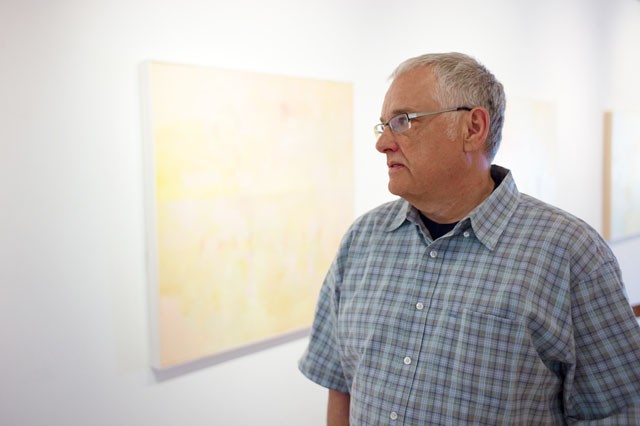What: âÄúInnuendoâÄù
When: Now through June 25
Where: Rosalux Art Gallery, 1224 Second St. N.E.
Even with a wealth of local gallery spaces, abstract expressionism seems to be an absent discipline among Minneapolis exhibition walls.
Part of it is just plain progress. A communityâÄôs creative compass is usually guided by the fledglings rather than the elders. While this post-modern era âÄî with its high premium on sociopolitical consciousness âÄî may have relegated modernist technique to a lower pedestal, Minneapolis artist James Wrayge is continuing to tease out the timeless merit of artâÄôs hallmark movement.
WraygeâÄôs current exhibition, âÄúInnuendo,âÄù at Northeast MinneapolisâÄô Rosalux Art Gallery explores the expressive capacity of the visual world outside the figurative. While Wrayge dabbled lightly in portrait work earlier in his 30-year career, he has always been drawn back toward abstraction.
âÄúI never had an interest in painting until I saw Franz Kline, and it just knocked me out,âÄù he said. âÄúI painted in only black and white for several years.âÄù
However, such stark color contrasts are absent in WraygeâÄôs new collection, which is built around layered pearly hues. âÄúInnuendoâÄù explores a greater depth of color pallet and lessened visual dichotomies. While he may not work from the same message-driven vantage point of the Twin CitiesâÄô younger artists, the emotive state of the world still seems to have a transformative power within his work.
âÄúI felt the need for some more calmness,âÄù Wrayge, who is a University of Minnesota alumnus, said. âÄúEverything around the world was going crazy when I started doing these and people were hostile. I wanted a little gentler world around me now.âÄù
The work pervades with tranquility. The large square canvas of his piece, âÄúCorner Blue, Mother of Pearl,âÄù pits a textured range of soft pinks and whites against subtle rectangular strokes. The imageâÄôs squared blue section uncovers an iridescent quality to these oceanic colors âÄî a technique that enhances the pieceâÄôs seashell namesake. Even in this realm of expressive abstraction, Wrayge assures that representative powers remain subtly at play.
âÄúPeople are always trying to imagine what they see in these things, and I didnâÄôt force any images,âÄù he said. âÄúBut [the images] definitely are in there.âÄù
His archetypal titles can often act as a guiding hand. It may not be reflective of any literal portrayals, but the emotive resonance of his chosen signifiers help stir the intended sensations. His piece, âÄúMikado,âÄù offers one of the exhibitionâÄôs greatest level of blatant contrasts amidst straight lines, curved angles, blacks and pinks. For Wrayge, the creative process is as shifting as the interpretive experience.
âÄúWith each piece, I have a very loose idea, because it always changes as you work,âÄù he said. âÄúIâÄôm not forcing anything on the work in terms of message or representation,âÄù he said. âÄúIt just comes.âÄù
It is this sort of process that shaped the modernist landscape almost a century ago âÄî the sublime exploration of the purely visual. Even with an absence of rules or representative endgames, there remains something wholly unique to the author within such work.
âÄúItâÄôs what excites me the most and what I find the most adventurous,âÄù he said. âÄúYouâÄôre not restricted to a format, and I like that. You can take it as it happens like a composer sitting at a piano who hits a note and fills it in from there.âÄù








